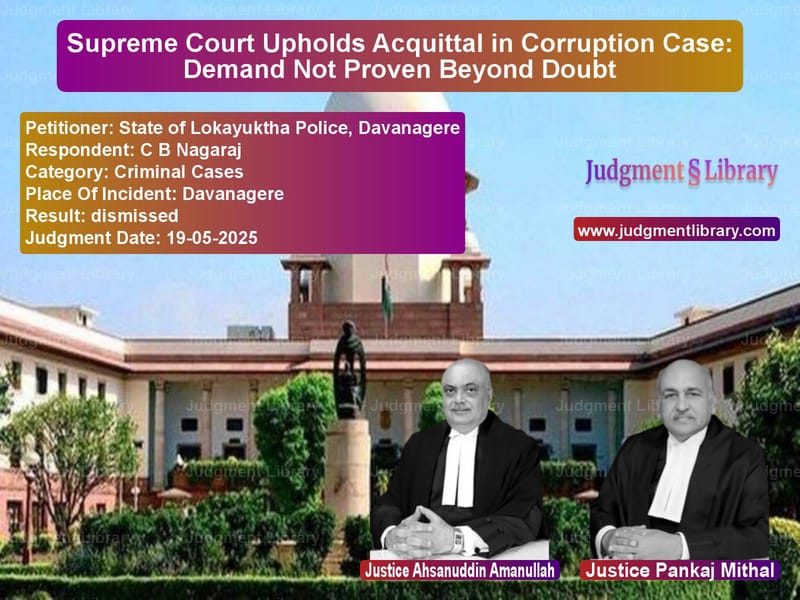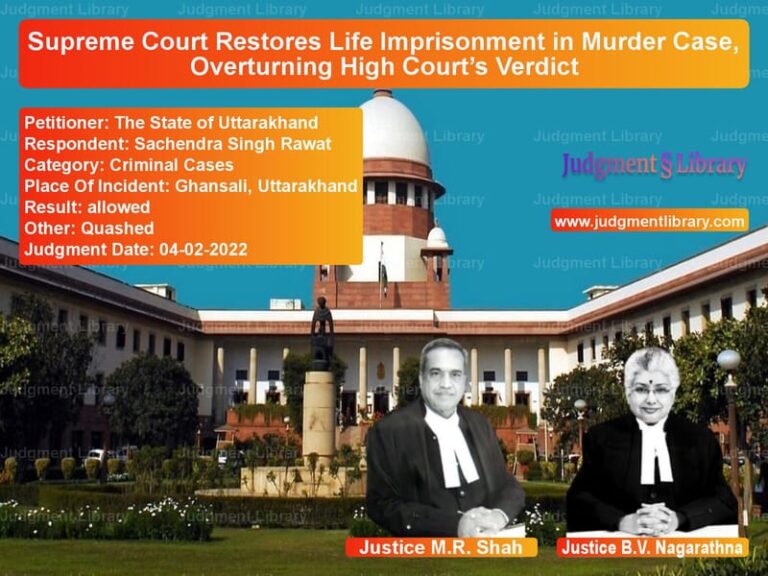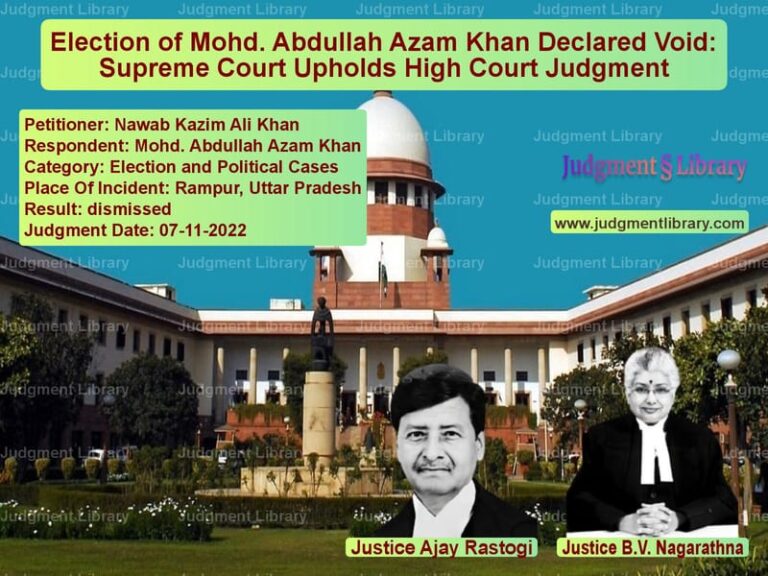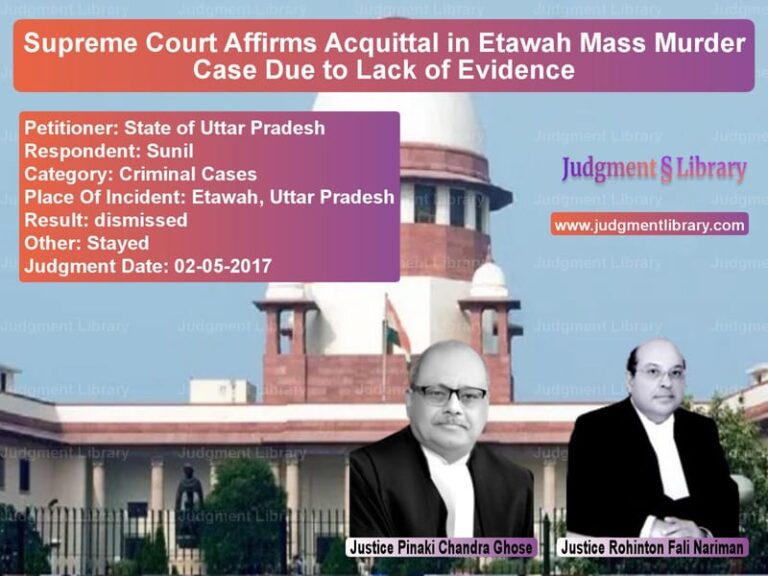Supreme Court Upholds Acquittal in Corruption Case: Demand Not Proven Beyond Doubt
In a significant judgment that underscores the importance of proving all elements of a corruption charge beyond reasonable doubt, the Supreme Court of India recently dismissed an appeal filed by the Lokayuktha Police against the acquittal of a government official accused of accepting bribe. The case of State of Lokayuktha Police, Davanagere versus C B Nagaraj, decided on May 19, 2025, by a bench comprising Justice Ahsanuddin Amanullah and Justice Pankaj Mithal, delves deep into the legal requirements for proving corruption charges under the Prevention of Corruption Act, 1988, particularly emphasizing the crucial element of ‘demand’ that must be established for a successful prosecution. This judgment reinforces the principle that while fighting corruption is essential, the courts must ensure that convictions are based on solid evidence that proves all components of the offense beyond reasonable doubt.
The Corruption Allegation and Legal Proceedings
The case centered around C B Nagaraj, who was working as an Extension Officer in the office of the Taluka Panchayath, Davanagere. The complainant, E R Krishnamurthy, had applied for a Validity Certificate for his claim under Category-II A for appointment as a Primary School Teacher. The process required the matter to be placed before the Caste Scrutiny Committee along with a spot inspection report to be prepared by the respondent official.
The prosecution’s case alleged that on February 7, 2007, when the complainant visited the respondent’s office at around 12:30 PM to enquire about the certified copy of the Validity Certificate, the respondent demanded illegal gratification of Rs. 1,500 to submit the spot inspection report. The complainant claimed he told the respondent he didn’t have the money but would return in the evening. He then approached the Lokayuktha Police, who organized a trap operation.
Read also: https://judgmentlibrary.com/supreme-court-cancels-bail-in-murder-case-land-dispute-turns-deadly/
Later that same day between 5:30 PM and 5:45 PM, the trap was executed. The complainant allegedly paid the respondent Rs. 1,500 in phenolphthalein-smeared currency notes, which were subsequently recovered from the respondent. The respondent’s fingers were dipped in sodium carbonate solution, which turned pink due to the presence of phenolphthalein, indicating contact with the treated currency notes.
The Trial Court convicted the respondent under Sections 7, 13(1)(d) read with 13(2) of the Prevention of Corruption Act, sentencing him to six months simple imprisonment and a fine of Rs. 2,000 for the offense under Section 7, and two years simple imprisonment with a fine of Rs. 3,000 for offenses under Sections 13(1)(d) read with 13(2). However, the High Court set aside this conviction in appeal, leading the State through Lokayuktha Police to approach the Supreme Court.
The Prosecution’s Arguments
The appellant State, represented by the Lokayuktha Police, made several key arguments seeking restoration of the conviction. “The learned counsel for the Appellant contended that the presumption under Section 20 of the Act, comes into play once demand and acceptance of a sum of money is proved.” The prosecution emphasized that once demand and acceptance are established, the burden shifts to the accused to rebut the presumption.
The prosecution argued that “this presumption, though being rebuttable at the option of the accused, the Respondent herein did not adduce any material evidence, and also did not cross-examine the prosecution witness on this point.” They maintained that the respondent had failed to discharge this burden.
Regarding the recovery of money, the prosecution submitted that “the prosecution on the other hand, had proved beyond all reasonable doubt that the recovery of the tainted currency notes amounting to Rs.1,500/- from the possession of the Respondent, was a bribe.”
The prosecution relied heavily on the Supreme Court’s decision in State of Karnataka v Chandrasha, arguing that “Section 20 gets attracted when it is proved that the public servant has accepted or agreed to accept any gratification other than legal remuneration and in that case, presumption is that it is the motive or reward for any of the acts covered under Section 7, 11, or 13(1)(b) of the Act.” They emphasized that “the presumption under Section 20 of the Act is similar to the presumption under Section 118 of the Negotiable Instruments Act, 1881, where the onus is on the accused to prove that he is not guilty of the offences charged.”
The prosecution dismissed the respondent’s explanation that the money represented repayment of a loan, stating that “the explanation offered by the Respondent – that the money received by him was repayment of money lent by the Respondent to the Complainant on an earlier occasion, is clearly not worthy of being accepted.” They concluded that “upon the aspects of ‘demand’ and ‘acceptance’ of the bribe amount being established beyond doubt, no two views are possible in the matter.”
The Defense’s Counterarguments
The respondent’s counsel presented a three-pronged defense challenging the prosecution’s case. “Firstly, learned counsel submitted that the evidence of the Complainant is not credible and shows mala fide conduct.” The defense highlighted inconsistencies in the complainant’s testimony, particularly regarding his denial and subsequent admission of the spot inspection report.
The defense pointed out that “the Complainant with oblique intentions denied the spot inspection report though he had signed it. However, when he was confronted with the said spot inspection report, he conceded thereto, stating that it was signed by him and his father.” This, they argued, demonstrated the complainant’s lack of credibility.
“Secondly, it was urged that the Complainant was aware that the spot inspection report had already been sent to the concerned department, and there was no work pending with the Respondent, at the time of the alleged demand.” This argument questioned the very motive for the alleged bribe demand, since the work had reportedly already been completed.
“Thirdly, learned counsel contended that the Respondent has been consistently stating, right from the time of seizure, without any afterthought, that the alleged bribe recovered from the Respondent, was only repayment of amount that was given to the Complainant at the time of the spot inspection.” The defense maintained that the money represented a legitimate loan repayment, not a bribe.
The defense also highlighted the respondent’s personal circumstances, stating that “the Respondent is a 67-year-old, award-receiving serviceman with an impeccable service record, and suffers from permanent visual disability and old age ailments.” They urged the Court to dismiss the appeal in the interest of justice.
The Supreme Court’s Detailed Analysis
The Supreme Court conducted a thorough examination of the evidence and legal principles involved. The Court noted that “the entire episode hinges around the aforesaid factual narrow compass” and focused particularly on whether the prosecution had successfully proved the element of demand beyond reasonable doubt.
The Court carefully analyzed the testimony of prosecution witnesses, particularly PW2, who was supposed to be a key witness to the demand. The Court observed that “in his cross-examination, initially PW2 stated that he had not heard the conversation between the Respondent and the Complainant which occurred inside the chamber of the Respondent, as he was standing near the entrance door.” However, “PW2 later stated that when the Respondent and the Complainant came down, he followed them, and the Respondent demanded the bribe amount from the Complainant, and thereafter, when they walked down the stairs, he had seen the Complainant give the bribe amount to the Respondent from a distance of 2 to 3 feet.”
The Court found PW2’s testimony problematic, noting that “PW2 further stated that he did not know whether the Respondent had asked the Complainant for the amount he had given to him.” The Court concluded that “except for this reference, coming in the deposition of PW2 apart from that of the Complainant himself i.e., PW1, no other witness has testified to being privy of such demand.”
The Court expressed serious concerns about the complainant’s credibility, stating that “a glaring pointer in this regard is the fact that the Complainant categorically stated in his deposition that he was not aware of any spot inspection report by the accused on 05.02.2007, however the moment he was confronted with the document viz. Exhibit D8, he, without demur, accepted the same.” The Court further noted that “not stopping at acceptance, the Complainant also admitted to have signed on the document and identified both his and his father’s signature as also of the witness.”
The Court identified a crucial logical flaw in the prosecution’s case: “when the Complainant went back to the Respondent’s office at 5:30 PM with the money, the prosecution case itself as per the deposition of its witnesses makes it clear that the Respondent had informed the Complainant that he had already forwarded the concerned file. Thus, if the same is accepted, there was no occasion for the Complainant to go ahead with paying the amount, which he claims to be in the nature of bribe demanded by the Respondent, after the work for which the bribe was purportedly sought, had already been done.”
Legal Principles on Presumption and Burden of Proof
The Supreme Court addressed the prosecution’s reliance on the presumption under Section 20 of the Prevention of Corruption Act. The Court agreed with the High Court’s observation “that just because money changed hands, in cases like the present, it cannot be ipso facto presumed that the same was pursuant to a demand, for the law requires that for conviction under the Act, an entire chain – beginning from demand, acceptance, and recovery has to be completed.”
The Court emphasized that “in the case at hand, when the initial demand itself is suspicious, even if the two other components – of payment and recovery can be held to have been proved, the chain would not be complete.” This reasoning highlighted the importance of proving all elements of the offense, not just the recovery of money.
The Court reinforced the principle that “a penal law has to be strictly construed” and cited several recent decisions supporting this approach. The Court distinguished the Chandrasha case relied upon by the prosecution, stating that “Chandrasha (supra) would not apply as demand has not been proven.”
The Court placed significant reliance on Paritala Sudhakar v State of Telangana, which had stated: “As far as the submission of the State is that the presumption under Section 20 of the Act, as it then was, would operate against the Appellant is concerned, our analysis supra would indicate that the factum of demand, in the backdrop of an element of animus between the Appellant and complainant, is not proved. In such circumstances, the presumption under Section 20 of the Act would not militate against the Appellant, in terms of the pronouncement in Om Parkash v. State of Haryana.”
The Court particularly emphasized the principle from Om Parkash that “Even otherwise, where demand has not been proved, Section 20 will also have no application.” This settled the legal position that the presumption under Section 20 cannot be invoked unless the foundational fact of demand is first established.
Assessment of Witness Credibility
The Supreme Court conducted a meticulous assessment of the complainant’s credibility, which proved decisive in the case. The Court found that “the testimony of the Complainant, as discussed supra, does not inspire confidence, inasmuch as, for reasons best known to him alone, he completely denied the visit of the Respondent for spot inspection, that too, just two days prior to the date of the trap and immediately changed such stance by accepting such visit and admitting the spot report as also identifying his own, his father’s and the witness’s signatures.”
The Court concluded that “in the considered opinion of this Court, such conduct is sufficient to render his testimony unreliable.” This finding was crucial since the complainant’s testimony was the primary evidence regarding the initial demand of bribe.
While acknowledging that “the High Court was required to give detailed factual reasoning, which has not been done, as to why it was overturning an order of conviction by that of acquittal,” the Supreme Court found that this deficiency did not affect the ultimate correctness of the High Court’s decision since “the factum of demand itself has not been proved beyond reasonable doubt.”
Conclusion and Legal Significance
The Supreme Court’s judgment in this case reinforces several fundamental principles in corruption jurisprudence. First, it emphasizes that all components of a corruption charge – particularly the crucial element of ‘demand’ – must be proved beyond reasonable doubt. Second, it clarifies that the presumption under Section 20 of the Prevention of Corruption Act applies only when the foundational fact of demand is established. Third, it underscores the importance of witness credibility, especially in cases relying heavily on the testimony of the complainant.
The Court’s approach demonstrates the delicate balance courts must maintain between the need to combat corruption effectively and the requirement to ensure that convictions are based on solid, reliable evidence. By dismissing the appeal and upholding the acquittal, the Supreme Court has sent a clear message that while corruption must be fought vigorously, this fight must be conducted within the framework of established legal principles and evidential standards.
This judgment serves as an important precedent for future corruption cases, particularly those relying on trap operations. It emphasizes that successful prosecution requires proving the complete chain of events – from initial demand through acceptance to recovery – and that deficiencies in proving any component, especially the initial demand, can prove fatal to the prosecution’s case.
For the respondent C B Nagaraj, this judgment brings closure to an 18-year legal battle that began with the alleged offense in 2007. For the legal system, it reinforces the fundamental principle that in criminal cases, particularly those under special statutes with reverse onus clauses, the courts must meticulously examine whether the prosecution has established all foundational facts before invoking statutory presumptions against the accused.
Petitioner Name: State of Lokayuktha Police, Davanagere.Respondent Name: C B Nagaraj.Judgment By: Justice Ahsanuddin Amanullah, Justice Pankaj Mithal.Place Of Incident: Davanagere.Judgment Date: 19-05-2025.Result: dismissed.
Don’t miss out on the full details! Download the complete judgment in PDF format below and gain valuable insights instantly!
Download Judgment: state-of-lokayuktha-vs-c-b-nagaraj-supreme-court-of-india-judgment-dated-19-05-2025.pdf
Directly Download Judgment: Directly download this Judgment
See all petitions in Evidence Law
See all petitions in Judgment by Ahsanuddin Amanullah
See all petitions in Judgment by Pankaj Mithal
See all petitions in dismissed
See all petitions in supreme court of India judgments May 2025
See all petitions in 2025 judgments
See all posts in Criminal Cases Category
See all allowed petitions in Criminal Cases Category
See all Dismissed petitions in Criminal Cases Category
See all partially allowed petitions in Criminal Cases Category







